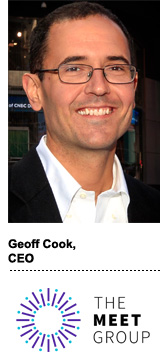
In less than two years, The Meet Group managed to diversify its revenue from a near total dependence on programmatic advertising to a healthy mix of ads, in-app purchases and subscriptions.
“I’d say 90% of our revenue was ad-driven before we started to shift,” said Geoff Cook, CEO of The Meet Group, which owns a portfolio of dating, chat and social networking apps, including Skout, Tagged and MeetMe with more than 4 million daily active users combined.
In late 2016, The Meet Group built a live-streaming video business modeled after Momo, a Chinese dating app which was able to make nearly $200 million per quarter within a year of introducing live video into its platform.
The Meet Group quickly rounded out its live video offering with one-on-one video chats and a feature, released in December 2018, that lets two people live stream timed competitions, like dance battles or rap duels. Viewers purchase virtual gifts in appreciation of the streamer’s talents, which generates revenue for the creator and the company.
In the 15 months since The Meet Group launched live-streaming video, annualized video revenue alone is more than $70 million.
AdExchanger chatted with Cook.
AdExchanger: Why did you diversify your revenue?
GEOFF COOK: The programmatic advertising market came under pressure in 2017. CPMs were down. We saw some improvement every quarter of 2018, but 2017 was a tough year for programmatic.
In October 2017, we picked up a sizable subscription business when we acquired Lovoo, a dating app based in Germany. At the time of the acquisition, half of its revenue – a little north of $300 million – came from subscriptions, and that’s only grown. Our live-streaming video business is monetized through users giving each other virtual gifts, and that added in a big slice of in-app purchase revenue.
Why is live streaming such a potent monetization opportunity for dating and chat apps?
Chat is traditionally one-on-one. Video fits into this easily as a form of chat.
But video can also help fill in the stale moments when people aren’t receiving enough in the way of text-based chats or they’re waiting for a response, which is frequently the case. We can reduce the loneliness people feel and create more engagement in those moments.
More than 20% of our daily users and as many as half of our monthly active users spend 20 minutes a day watching live streams. That enables us to dramatically increase the amount of time we have with users and it monetizes in a fairly novel way – through in-app revenue – which allows us to diversify away from advertising.
What led to the idea for Battles?
 Every major Asian app that has live streaming also has some version that allows streamers to battle. Viewers can see both streams, which are joined. The winner of the battle is the streamer who gets the most votes expressed as points via the gifting function. Streamers like this feature, because it brings in viewers and it provides a monetization upside. Streamers get a 40% rev share.
Every major Asian app that has live streaming also has some version that allows streamers to battle. Viewers can see both streams, which are joined. The winner of the battle is the streamer who gets the most votes expressed as points via the gifting function. Streamers like this feature, because it brings in viewers and it provides a monetization upside. Streamers get a 40% rev share.
Why is Asia such an inspiration for your product team?
China actually has a more open and less controlled social landscape than the United States, where it’s mostly Facebook, Instagram and some Twitter – and those companies aren’t motivated to split 30-40% of revenue with creators. But a number of different companies in China pursue that model [in terms of rev share]. China is a massive market, dollars are flowing and billions are being invested in live streaming and short video. Look at the success of something like TikTok.
We’re very attuned to what’s happening in China. Every couple of weeks we check to see what all the major Chinese companies are doing to make sure we understand the nuances of their features.
What’s your ideal revenue mix?
We haven’t said exactly what our mix numbers will look like, but now it’s about 40% advertising, 60% users pay, and I would expect that if the past is any guide, we’re going to see user pay continue to grow. Video revenue was exceptional in 2018 and Lovoo subscribers were strong. We’d like to see those trends continue.
This year, we’ll be exploring different ways to monetize the video we have. Rewarded is one way, but there’s also more we can do to bring in supply. When I say we’ve made $70 million plus in annualized revenue off of video, that’s off just 5% of video. We’re still not directly monetizing 95% of the video we have.
This post was syndicated from Ad Exchanger.


More Stories
The POV From Possible: When Will The Digital Ad Industry Stop Navel-Gazing And Realize Its Potential?
Lush’s beauty revolution with Sling & Stone
In Bridgerton and Flonase Collaboration, Both Love and Allergies Are in Bloom